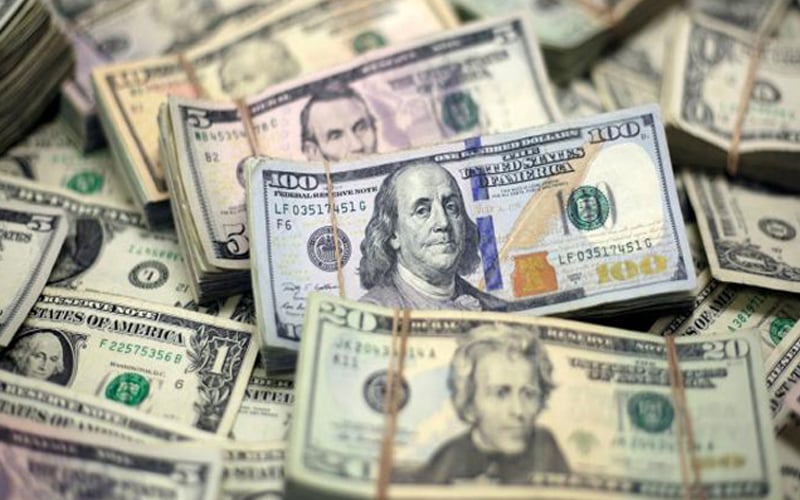
Published by Focus Malaysia, Free Malaysia Today, Business Today & Biztech.asia, image from Free Malaysia Today.
With the rise of China’s renminbi (RMB) and its internationalisation, a question mark naturally arises as to whether the US dollar (USD) as the world’s “reserve currency” can still be sustained sometime in the future.
All of this, of course, is inextricably linked to geopolitics and geo-economics.
Meanwhile in Malaysia, should the ringgit depreciate drastically against the USD, our headline inflation might hypothetically then spike from the present figures of between -1.5% and 0.5% to beyond the projected figures of between 1% and 3% given our dependence on food imports.
Such a scenario might ensue in inflation outpacing our GDP’s expected recovery of between 5.5% and 8% as projected by Bank Negara in its Quarterly Bulletin for the second quarter of 2020 (2Q20).
In which case, we have to hope that our current account surplus widens further on the back of manufacturing, tourism and not least high enough oil prices on the back of a weaker ringgit – no less.
A weaker currency has been part of that trend of competitive devaluation against the US Dollar (USD) in recent years.
In this, our currency’s relative value to the USD, whether by design or not, inevitably plays into the geo-economics game, that at the end of the day is all about entrenching the USD’s hegemonic status and for a long time to come.
Now, we see this played out in Trump’s rebalancing policy under the auspices of the “America First” agenda resulting in protectionist measures by way of slapping import tariffs on Chinese-made or originated goods.
In what is a parallel to the Triffin Paradox under the gold standard exchange, reducing the US’ trade or current account deficit with China actually strengthens the USD.
The Triffin Paradox – as associated with the Belgian-American economist Robert Triffin – meant that sustaining the USD as the world’s reserve currency required the US to run external deficits against the rest of the world continuously. But this tend to weaken the confidence in the value of USD which led to increased demands for convertibility back into gold.
Ultimately, this would led to the unravelling of the entire international payments system with the USD as the world’s reserve currency in 1971.
Back then, Richard Nixon took the US off the gold standard exchange in order to deficit finance the Vietnam War. This currency decoupling in turn led to the rest of the world following suit, by default and hence, heralding the era of fiat currencies.
Fast forward, China’s holdings of US Treasury bills, therefore, doesn’t affect the US’ ability to deficit finance. Rather it simply means the less holdings China holds, the less debt the US needs to issue to repay, which in turn reduces the capital account deficit. This means there’s less demand for USD to be converted into yuan and hence the argument that it maintains the USD as the world’s leading reserve currency.
As for quantitative easing (QE) which meant that the central banks of the US, UK and Japan were engaged in bond buying at the secondary markets, it ensured that yields remained low on the longer end (long-term maturity) of the yield curve.
This has also resulted in geopolitical and geo-economic repercussions. Lower interest rates in the US encouraged capital to seek higher returns in both fixed-income and equity in emerging markets. This resulted in unnatural appreciation in the value of assets, leading to the real estate bubble worldwide that we saw just before the Global Financial Recession (GFC) of 2008.
At the same time, cheaper borrowings resulted in speculative activities in commodities including staple food imports such as wheat, which fed into the escalating food inflation in the importing countries that ignited the Arab Spring in the aftermath of the 2008 GFC.
But QE also entrenched the dominant status of the USD by rallying the domestic stock market. The corporate share buy-backs, for instance, soared the dividend pay-outs which transmitted into consumer sentiment that re-established the pattern of imports from the rest of the world.
In other words, QE with its depreciating impact on the USD didn’t portend the end of the currency’s dominance. On the contrary, QE enabled a new round of USD-based activities to influence the global financial markets with economic ramifications.
At about the same time, however, China had begun concerted efforts aimed at the internationalisation of the RMB. Its entry into the World Trade Organisation (WTO) in 2001 marked its maturing into a full-fledged member of the international economic order. This could be seen in the bilateral swap arrangements and cross-border settlements in RMB which among other things minimised transaction costs.
The UK’s openness in 2011 to host an off-shore centre for the internationalisation of the RMB boosted the currency’s status vis-à-vis the USD.
More recently, the One Belt, One Road (OBOR) mega-project spanning three major continents and the world’s longest modern land bridge as well as China’s growing outreach and debt diplomacy to Africa and the Pacific certainly served to elevate the status of the RMB as a potential rival and serious competitor that can challenge the USD’s currency dominance.
However, it could be argued that the backlash from debtor nations in response to what is known as “debt trap” – rightfully or wrongfully – has diminished and contained the RMB’s prestige somewhat.
So, all in all, the USD will continue long into the foreseeable future as the world’s reserve currency even amidst QEs and the internationalisation of the RMB.
Jason Loh Seong Wei is Head of Social, Law and Human Rights at EMIR Research, an independent think tank focused on strategic policy recommendations based on rigorous research.
Diterbitkan oleh The Malaysian Insight.
Dengan kebangkitan renminbi (RMB) China dan pengantarabangsaannya, satu tanda tanya muncul: adakah dolar AS (USD) sebagai “mata wang rizab” dunia masih dapat dikekalkan pada masa akan datang?
Semua ini sememangnya berkait rapat dengan geopolitik dan geo-ekonomi.
Sementara di Malaysia, sekiranya ringgit menyusut secara drastik berbanding USD, inflasi utama kita mungkin secara hipotetikalnya melonjak dari angka sekarang antara -1.5% dan 0.5% hingga melebihi angka yang diunjurkan, iaitu antara 1% dan 3%.
Ini kerana kebergantungan kita kepada import makanan.
Senario itu mungkin menyebabkan inflasi melebihi pemulihan KDNK yang dijangkakan di antara 5.5% hingga 8%, seperti yang diunjurkan Bank Negara dalam Buletin Suku Tahunan untuk suku kedua (Q2) 2020.
Justeru, kita perlu berharap lebihan akaun semasa kita meningkat lagi berlandaskan sektor pembuatan, pelancongan dan dan tidak kurang juga harga minyak yang cukup tinggi berikutan nilai ringgit yang lemah.
Mata wang yang lemah telah menjadi sebahagian daripada trend penurunan nilai kompetitif terhadap USD dalam beberapa tahun kebelakangan ini.
Dalam hal ini, nilai mata wang kita berbanding USD, sama ada terancang atau tidak, pasti akan terjebak dalam permainan geo-ekonomi yang pada akhirnya hanya memperkukuhkan status hegemoni USD untuk jangka masa yang akan datang.
Kini, hal ini dilihat dimainkan dalam dasar pengimbangan semula Donald Trump di bawah agenda “America First” yang menghasilkan langkah perlindungan industri tempatan dengan cara memotong tarif import ke atas barang buatan China atau apa-apa yang berasal daripada negara itu.
Sejajar dengan Paradoks Triffin di bawah standard pertukaran emas, mengurangkan defisit perdagangan atau akaun semasa AS dengan China sebenarnya menguatkan USD.
Paradoks Triffin – yang dikaitkan dengan ahli ekonomi Belgian-Amerika Robert Triffin – bermaksud ketetapan USD sebagai mata wang rizab dunia memerlukan AS untuk menjalankan defisit luaran terhadap seluruh dunia secara berterusan.
Namun, ini akan menyebabkan kepercayaan terhadap nilai USD menjadi semakin lemah, dan seterusnya membawa kepada peningkatan permintaan untuk menukar kembali kepada emas.
Ini akhirnya menyebabkan kemerosotan keseluruhan sistem pembayaran antarabangsa dengan USD sebagai mata wang rizab dunia pada 1971.
Bagi pelonggaran kuantitatif (QE) pula yang bermaksud bank pusat AS, UK dan Jepun terlibat dalam pembelian bon di pasaran kedua, ia memastikan pulangan tetap rendah pada jangka panjang (kematangan jangka panjang) untuk keluk hasil.
Ini juga mengakibatkan kesan geopolitik dan geo-ekonomi. Kadar faedah yang lebih rendah di AS menggalakkan modal untuk mendapatkan pulangan yang lebih tinggi daripada pendapatan tetap dan ekuiti di pasaran baharu.
Pada masa yang sama, pinjaman yang lebih murah telah menghasilkan aktiviti spekulatif dalam pasaran komoditi termasuk import makanan ruji seperti gandum, di mana inflasi makanan naik dengan ketara di negara-negara pengimport dan mencetuskan Kebangkitan Arab (Arab Spring) pasca Krisis Ekonomi 2008.
Tetapi QE juga mengukuhkan status dominan USD dengan menggerakkan pasaran saham domestik.
Pembelian balik saham korporat, misalnya, melonjak pembayaran dividen yang kemudiannya disalurkan dalam bentuk sentimen pengguna. Ini seterusnya telah mengembalikan semula trend import dari seluruh dunia.
Namun, pada waktu yang sama, China memulakan usaha tertumpu yang bertujuan untuk mengantarabangsakan RMB.
Kemasukannya ke Pertubuhan Perdagangan Dunia (WTO) pada 2001 menandakan fasa kematangan menjadi anggota ekonomi antarabangsa.
Ini dapat dilihat dalam pengaturan pertukaran dua hala dan pembayaran rentas sempadan dalam RMB yang antara lainnya meminimumkan kos transaksi.
Keterbukaan UK pada 2011 untuk menjadi tuan rumah pusat pesisir pengantarabangsaan RMB meningkatkan status mata wang berbanding USD.
Baru-baru ini, projek mega Satu Jalur Satu Jalan ( (OBOR) merangkumi tiga benua utama dan jambatan darat moden terpanjang di dunia serta jangkauan China yang semakin meluas dan juga diplomasi hutang di Afrika dan Pasifik tentunya berfungsi dalam meningkatkan status RMB sebagai calon pesaing serius yang boleh mencabar dominasi mata wang USD.
Namun, dapat dikatakan tindak balas negatif dari negara penghutang atau lebih dikenali sebagai “perangkap hutang” – betul atau salah – sedikit sebanyak mengurang dan menyekat kedudukan RMB.
Jadi, secara keseluruhannya, USD akan terus berlanjutan di masa yang akan datang sebagai mata wang rizab dunia walaupun sepanjang perlaksanaan QE serta pengantarabangsaan RMB.
Jason Loh Seong Wei merupakan Ketua Bahagian Sosial, Perundangan dan Hak Asasi di EMIR Research, sebuah badan pemikir bebas yang berfokuskan kepada pencernaan saranan-saranan dasar strategik berteraskan penyelidikan yang terperinci, konsisten dan menyeluruh.

